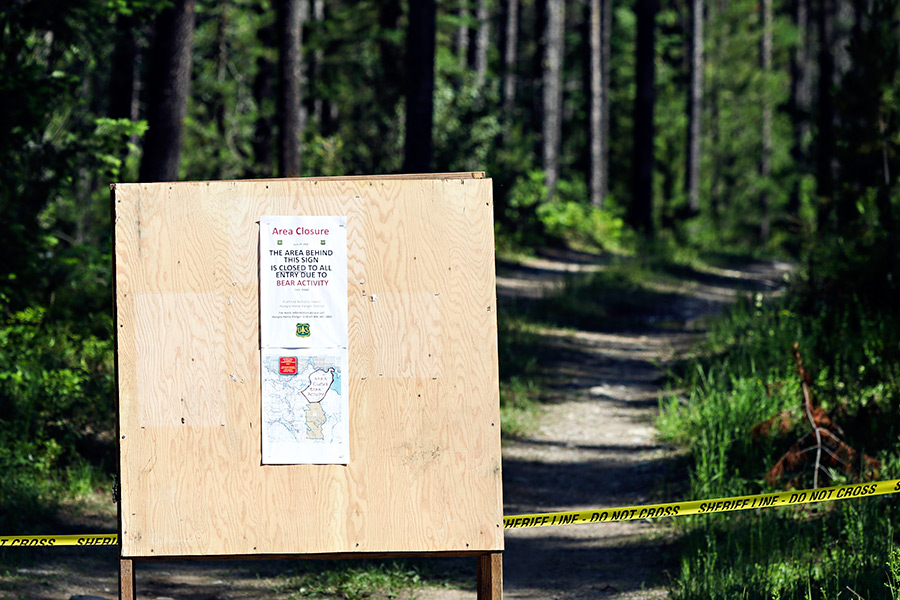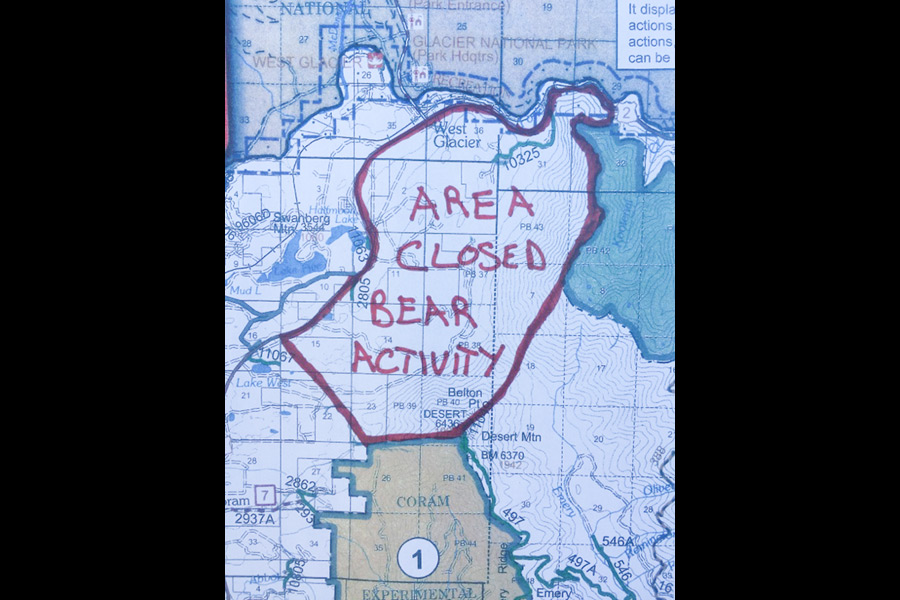Hopes Dimming But Search Continues for Bear that Killed Cyclist Near Glacier Park
Authorities trying to confirm it was a grizzly; Area closed near Halfmoon Lake
By Justin Franz & Dillon Tabish
Update: June 30, 6 p.m.
Wildlife officials are going to great lengths but hopes are dimming as they continue to search for a bear that killed a West Glacier man riding his mountain bike on a forested trail south of Glacier National Park.
Brian Sommers, an investigator with Montana Fish, Wildlife and Parks, said it was likely that the bear left the Halfmoon Lake area immediately after Wednesday’s fatal encounter. As time goes on, it is less and less likely that officials can capture the animal, Sommers said.
“We’re taking it one day at a time, seeing what results we get,” said FWP spokesman John Fraley. “You just can’t predict what a bear is going to do.”
The Associated Press reported that wildlife officials won’t know until next week whether the samples they collected at the site of the attack will contain usable DNA. If a bear is trapped, wildlife officials would have to hold it until then before deciding its fate.
Brad Treat, 38, of West Glacier, was killed Wednesday afternoon while mountain biking on the Green Gate/Halfmoon trail system on U.S. Forest Service land. Treat grew up in the Flathead Valley and graduated from Flathead High School, where he was a standout distance runner, in 1996.
Treat, a longtime Forest Service employee, and a family member were mountain biking when the riders surprised the bear around 2 p.m., according to an initial investigation. Treat was taken off his bike by the animal, according to Flathead County Sheriff Chuck Curry. The second rider escaped uninjured and summoned help.
Treat was pronounced dead at the scene. His body was transported out by an off-highway vehicle and was taken to the Montana State Crime Lab in Missoula. Curry said an autopsy would be conducted to gather information about the bear that killed Treat.
Authorities initially identified the bear as a grizzly, but state wildlife managers have collected DNA samples from the scene to officially confirm whether it was a grizzly bear or black bear.
“We are attempting to capture and/or confirm the identity of the offending bear,” FWP Warden Captain Lee Anderson stated. “When we have more information we will decide what actions to take.”
Curry said bear traps and remote cameras were set in the section of Flathead National Forest where the attack occurred in an effort to capture to animal. Two Bear Air, the local search and rescue helicopter, flew over the area of Wednesday’s fatal mauling but could not locate the animal.
The Green Gate/Halfmoon trail system off U.S. 2 remains closed and posted by U.S. Forest Service officials in the interest of public safety. Forest Service roads closed in that area include Pack Trail, Hog Haven, Belton Point Road, Halfmoon Lake Road, Belton Ski Course and Ryan Road. Landowners in the area are exempt from the road closures, although everyone is reminded to use caution while traveling through the area.
The sheriff’s office, the Montana Fish, Wildlife and Parks’ Wildlife Human Attack Response Team and the Forest Service are investigating the incident and searching for the bear up to West Glacier and the southern boundary of Glacier Park.
Treat worked as a law enforcement officer for the Forest Service in the Hungry Horse/Glacier View District.
“Brad was an integral member of our area law enforcement team and a friend to us all. Our thoughts and prayers are with his family tonight,” Curry said.
Tom Vilsack, secretary of the U.S. Department of Agriculture, released a statement Thursday morning following Treat’s death.
“I am saddened to hear of the passing of Officer Brad Treat, who was fatally attacked by a grizzly bear yesterday while biking on the Flathead National Forest in Montana with a family member,” Vilsack stated. “My thoughts are with Officer Treat’s family and loved ones as they grapple with this tragic news and a devastating loss. We are grateful for Officer Treat’s selfless service and share in mourning a life that was taken too soon. The brave men and women of the U.S. Forest Service risk their lives every day in difficult and challenging circumstances, and today we are reminded of their incredible service to our nation.”
Rob Davies, the Hungry Horse/Glacier View district ranger, described Treat as an exemplary officer who was highly skilled and an expert handling challenging situations in the backcountry.
“He’s super well-rounded and had an incredibly positive attitude. He could take a stressful situation and keep it light-hearted. Everyone around him was very excited to work with him,” Davies said. “His ability to deal with extremely stressful situations in a very professional and relaxed way was amazing.”
Davies said Treat built strong relationships and partnerships with various agencies across the valley and was active in the search and rescue operations. He was an avid outdoor recreationist.
Flags on the Flathead National Forest were lowered to half-mast on Thursday in honor of Treat.
Treat was married and lived in nearby West Glacier. Growing up in the valley, Treat developed into one of Montana’s best distance runners and helped form the long-distance dynasty at Flathead High School in the mid-90s. Along with his all-state accomplishments and tireless dedication, Treat’s kind-hearted demeanor left a lasting mark on the Brave program for years to come, according to his former coach, Paul Jorgensen.
“He’s one of the nicest kids I’ve coached,” Jorgensen, who has coached Flathead runners for nearly 40 years, said Wednesday night after learning of Treat’s death.
“One thing that really impressed me about him, we were running at the Missoula Invitational (cross country meet) and he was the top runner. He finished first and then he turned around and congratulated every kid that finished. That really impressed me. I told my kids that story off and on over the years and then my kids started doing that, too. Brad’s the one who started that. That’s the kind of kid he was.”
With Treat as one of its all-state distance runners, Flathead won a cross country state championship in 1994 and track state championships in 1995 and 1996. Treat’s 1996 time of 9:14.30 in the 3,200-meter race was the fastest in Montana history by a prep runner until it was surpassed three years later. As a senior, he won individual state championships in the 1,600 and 3,200 and ran on the championship long-relay team.
“He was a really good runner but he was also a kind-hearted person who cared about people,” Jorgensen said.
FWP’s Anderson noted that the thoughts and prayers of everyone go out to the Treat family and the U. S. Forest Service. Anderson thanked Glacier National Park, the Flathead County Sheriff’s Office, local search and rescue crews, Two Bear Air, ALERT, and Forest Service employees for their efforts.
The incident is under investigation and more details will be released as they become available, according to FWP.

Following fatal bear incidents, the common practice is that an independent board of experts is formed to review the facts and reconstruct the incident as possible. When an attack occurs outside a national park, the fate of the animal is based on consultations between FWP and U.S. Fish and Wildlife Service and is based on the presumed nature of the attack. Attacks can be surprise encounters with bears with or without cubs. Consumption of the victim or not, and other such factors, are used to make a decision on the bear.
In rare cases, the attack can be predatory in which case the bear is always removed, according to experts. These decisions on the fate of the bear can be made shortly after the incident based on the information collected. Chances of dealing with the correct bear decline with time so these decisions on the fate of the bear based on the information in hand have to be made relatively quickly, experts say.
Wildlife managers will try to determine if it was a mother with cubs, whether it was protecting a food cache nearby or whether it simply reacted to the surprise appearance of the bikers, Montana Fish, Wildlife and Parks spokesman Ron Aasheim told the Associated Press.
“One of the things that is key to all this is whether it was a predatory act,” Aasheim said. “I don’t think there’s any sense that this was predatory.”
In fall 2015, a black bear fatally attacked an elderly woman in her home near Kalispell. Barbara Paschke, 85, died Oct. 1 from injuries she suffered during a black bear attack inside her Ashley Lake home on Sept. 27. According to FWP, Paschke had been providing supplemental feed to bears and was previously cited in 2012. Wildlife managers suspended the search after failing to locate the animal.
If the attacking bear is identified as a grizzly, it would be the first fatal grizzly attack in Northwest Montana since 2001, when an elk hunter was killed on the Blackfoot Clearwater Game Range near Ovando.
Grizzly bear attacks are rare in the Glacier region but not unheard of. Since Glacier National Park was created in 1910, there have been 10 fatal grizzly attacks in the national park, the most recent in May 1998 when a 26-year-old man was killed hiking in the Upper Two Medicine Valley.
Northwest Montana is home to the largest grizzly bear population in the lower 48 states with approximately 1,000 bears living in the region. Grizzlies are listed as threatened under the Endangered Species Act.
There have been six fatal grizzly bear attacks since 2010 in the Yellowstone region of Montana, Wyoming and Idaho.
This story will be updated when more information becomes available.